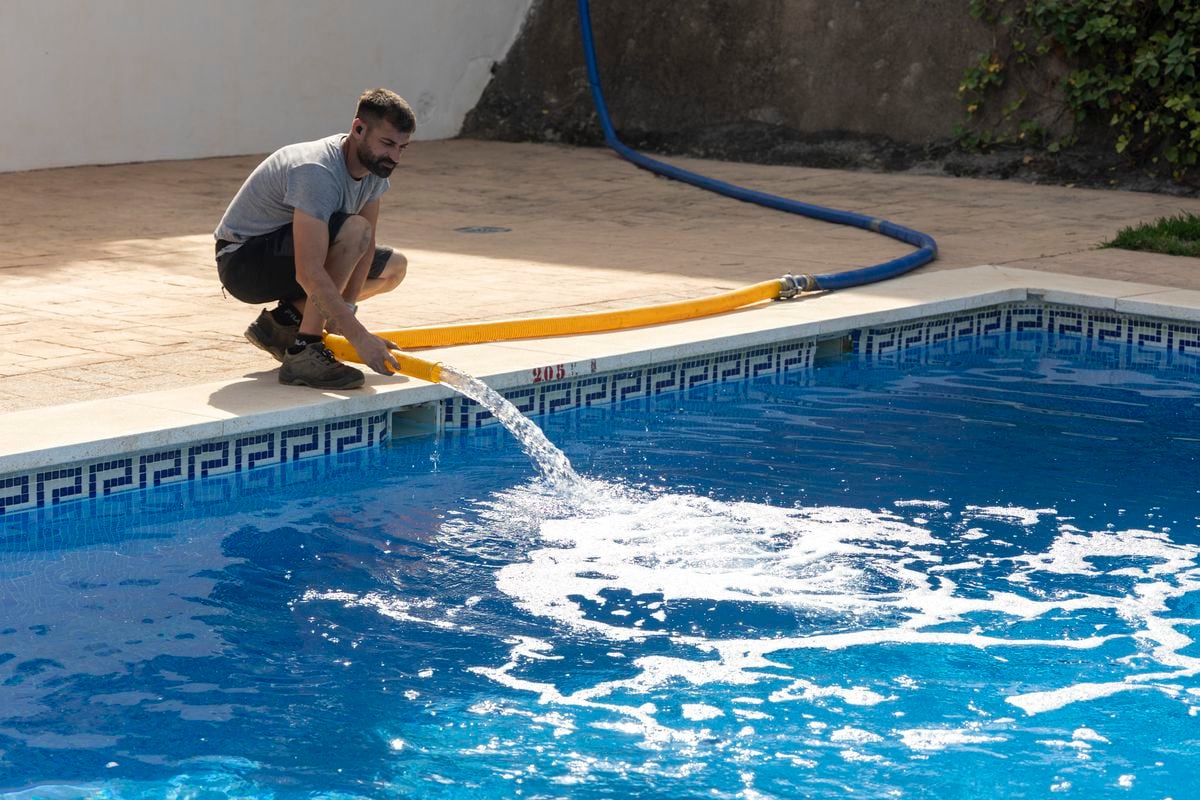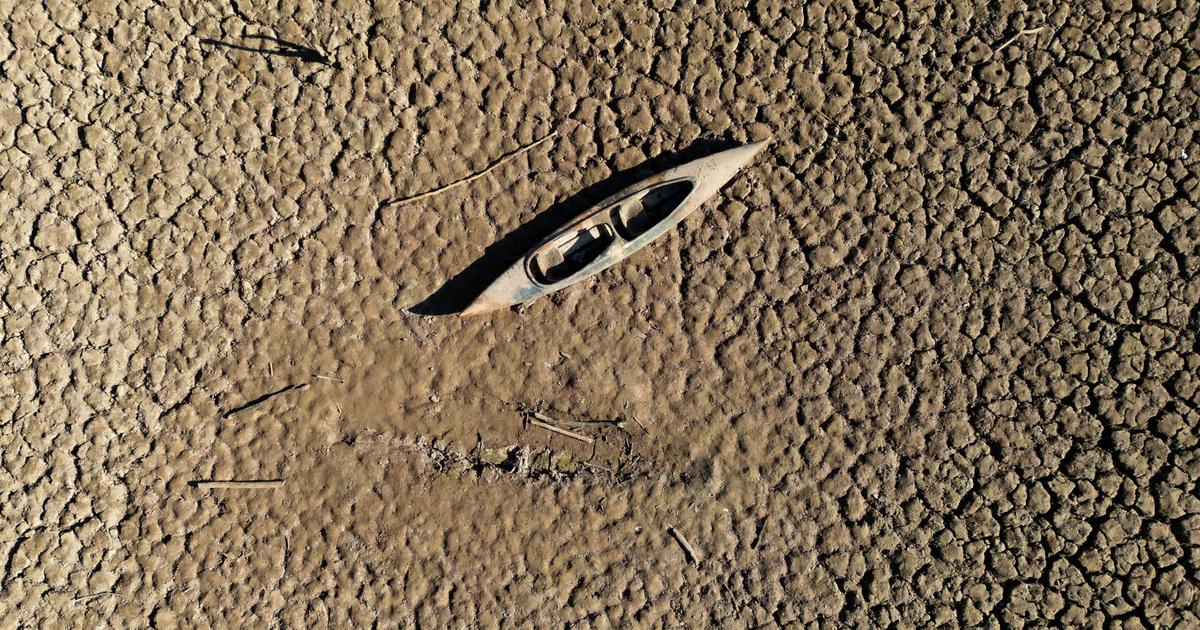The extreme heat and the almost total absence of rain in almost all of Spain are accelerating the emptying of the reservoirs and have already caused the first restrictions on consumption.
Although, at the moment, in a very limited way.
The water reserve, the stored water, is at 41.9%, 1.3 points less than the previous week and almost 20 points less than the average on these same dates, according to the Ministry of Ecological Transition.
The situation is not uniform, as there are basins below 30% (Guadiana, Guadalete-Barbate and Guadalquivir), some in a critical situation (the Viñuela reservoir, which supplies the Axarquia in Malaga, is already at 13%) and others, like that of the Júcar, in record of filling.
The combination of the lack of precipitation (it has rained 26% less than normal since October), the increase in water consumption due to high temperatures (in Madrid, for example, it grew by 9% in July) and the evaporation of the swamps and soils (the humidity of the surface layer of the soil is zero) have led to the adoption of restrictive measures in towns in Barcelona, Malaga, Pontevedra or Huelva, while contingency plans are already being made throughout Spain in the face of the evidence of an August in which the heat will continue and abundant rains, not storms, do not arrive.
The water stored in Spain has not exceeded this year at any time what was collected in 2020 and 2021. The reservoirs store a total of 23,523 cubic hectometres, when last year there were 27,958.
Between July 19 and 26 (data is updated weekly), the reserve has dropped by 737 hectometers.
In that time it has hardly rained at all: between last October and July, the average value of accumulated rainfall is estimated at 419 millimeters, 26% less than the normal value, which stands at 569 millimeters.
And so far this month, rainfall has been low on the Atlantic side and "practically zero on the Mediterranean side."
More information
August begins with a possible third heat wave, but "less intense than the previous ones"
Catalonia, the inner western third of the Peninsula, almost all of Andalusia (except for the eastern zone), the province of Guadalajara (with a dozen large reservoirs, including part of the Buendía reservoir, the fourth with the largest capacity) and the Canary Islands have not even reached 75% of normal rainfall values, according to the Spanish Meteorology Agency (Aemet).
On the other hand, there are areas where rainfall doubles the average value for the 1981-2010 period, such as some areas between Almería, Murcia, Granada, points along the coast of Valencia and Alicante.
Added to the lack of rain is the unusual heat, which has triggered evaporation and human consumption, which is accelerating the emptying of the reservoirs.
The water retained in the Ebro hydrographic basin, the one with the greatest capacity, has again dropped another 3.2% this week to stand at 54.8% of its capacity, with 4,336 cubic hectometres of the 7,917 that can be accommodated in its all the hydraulic infrastructures of the system, according to the data provided this Monday by the Hydrographic Confederation of the Ebro (CHE).
The basin does not exceed the average reserve of the last five years and is below the 2021 figure and the minimum, which occurred in 2017, with 4,753 hectometers and 60% of the total capacity.
Latest report on the situation of water reserves in the Ebro Basin.💦The weekly balance of reservoirs with a downward trend 📉 is 4,336 hm3 (54.8%), 261 hm3 less than last week.
More 👉https://t.co/XbxKQuu8uJ pic.twitter.com/Oy9SZ21G7U
– CH del Ebro (@CH_Ebro) August 1, 2022
The Canal de Isabel II, which manages the supply of the Community of Madrid, has reported that its reservoirs are at 64%, "a figure that is 6.4 points below the historical average and 9.2 points below the accumulated level just a year ago”.
The lack of rain in July and the very strong heat have resulted in a 9% increase in consumption, compared to that registered in the same month of 2021 (in June the rise was 11%).
And the rivers have not helped either, since their contribution in July has been 47.9% lower than usual.
Probability of #precipitation GREATER THAN 2 MM expected today in #Peninsula and #Balearic Islands, based on the EPS of the European Center.
More info at https://t.co/9PLsmvr65q pic.twitter.com/xLEDZIW8J2
– AEMET (@AEMET_Esp) August 1, 2022
The panorama has become bleak in places accustomed to rain and green, even in August.
The flow of the Lérez River, which supplies the region of Pontevedra, is at a minimum, which has forced the Pontevedra City Council to issue a decree prohibiting its 83,000 residents from filling swimming pools, washing private cars, flushing the streets or watering the gardens.
This Wednesday the Xunta plans to meet with the municipalities of the Pontevedra area to deal with "the pre-alert for scarcity" of water.
Meanwhile, the Catalan Water Agency (ACA) has declared a hydrological alert at the headwaters of the Ter, the middle Llobregat and the Anoia Gaià;
and he fears that in September harsh restrictions will have to be imposed if the rains do not correct it.
In fact, there are already restrictions in 15 municipalities in the Anoia region, in the province of Barcelona
The province of Cádiz has part of its ten reservoirs under a decree declaring an exceptional drought, despite the fact that it does not currently have water restrictions in sight.
The singularity is due to the fact that the absence of rain last February led the Barbate river basin and the Campo de Gibraltar area to the threat of water cuts.
However, heavy rains in April guaranteed the province —with 1.2 million inhabitants— a supply of water for next year.
Currently, the Cadiz reservoirs are at 29.71% of their capacity, a percentage similar to that of last summer.
A tree lies in a dry field in Guadalajara due to lack of rain. Pablo Blazquez Dominguez (Getty Images)
This level, added to the significant capacity of some reservoirs, such as Guadalcacín and Los Hurones, "guarantees human consumption for the province for now," explains Daniel Sánchez Román, regional delegate for Sustainable Development of the Junta de Andalucía in Cadiz.
However, the person in charge warns: "The restrictions are not contemplated, but it is true that with the heat waves the evaporation of water from the swamps is more pronounced."
Where they are not going to get rid of the water cuts in the short term is in Huelva.
The more than ten reservoirs in the province are at 25.93% of their capacity.
However, more than the low level or the forecast of no rain in the coming months, it is the combination of lack of infrastructure and drought that has led to restrictions on 15 towns in the Huelva mountains, supplied by aquifers and without connections. to these swamps.
Courts in the rainy areas of Huelva
The drop in reserves of these wells due to successive heat waves has led to restrictions being applied to municipalities in the Sierra de Aracena and Picos de Aroche, such as Cumbres de San Bartolomé, Valdelarco, Cumbres Mayores and Hinojales, which have been affected since mid-July due to night water cuts, despite the fact that, paradoxically, they are in one of the rainiest areas of the province.
The drought situation in Malaga and, especially, in regions such as Axarquia or the interior of the province, has led to decisions to reduce water consumption.
Thus, from this August 1, the Malaga municipalities of Vélez-Málaga, Rincón de la Victoria and Algarrobo will cut off the water from the showers on the beaches.
Therefore, three of the localities on the coast of the Costa del Sol-Axarquia have already opted for saving measures, given the complicated situation due to the scarce reserves of the La Viñuela reservoir, the largest in the province, but whose capacity is at limit, to 12.8%, due to the lack of rain.
Due to the situation of "Exceptional drought with serious scarcity" that we are suffering and the high risk of suffering water restrictions for human consumption, we have adopted exceptional measures that contribute to the control of the municipality's water resources.
#MedidasDroughtAlgarrobo pic.twitter.com/luywJaXMgb
– Carob (@ayto_algarrobo) August 1, 2022
A few days ago, the Association of Municipalities of the Costa del Sol Axarquia urged the municipalities to establish water saving plans to reduce consumption for human supply by 20%;
a measure included in the drought decree issued by the Junta de Andalucía.
It establishes the prohibition of using water resources suitable for human consumption for washing streets, filling private swimming pools, watering gardens, public and private parks, golf courses, washing cars outside authorized establishments, fountains ornamentals that do not have a closed water circuit, showers and public dispensers.
50% off
Subscribe to continue reading
read without limits
Keep reading
I'm already a subscriber









/cloudfront-eu-central-1.images.arcpublishing.com/prisa/R65LZW6EVZDNDFZPK25RWRQTVY.jpg)